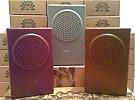FM3, "Buddha Machine II"
 The original Buddha Machine caused quite a stir when it first appeared a couple of years ago and the emergence of a second generation machine begs the question of whether such a device has a lifespan beyond that of a novelty toy? Having spent some time with both devices, my gut answer is yes, it is far more than a trinket. New loops, new colors and a new feature (control of playback speed) have breathed new life into an already spunky little gadget.
The original Buddha Machine caused quite a stir when it first appeared a couple of years ago and the emergence of a second generation machine begs the question of whether such a device has a lifespan beyond that of a novelty toy? Having spent some time with both devices, my gut answer is yes, it is far more than a trinket. New loops, new colors and a new feature (control of playback speed) have breathed new life into an already spunky little gadget.
As with the original, the loops here vary immensely in terms of how many times you can stand listening to them repeat. Of course (enters “Stating the obvious mode”) this all depends on personal taste, there are always going to be loops that just get on my nerves and that is true of both Buddha Machines. However, FM3’s Christiaan Virant and Zhang Jian have expanded the amount of audio per loop (although not as high as they had originally intended due to the limitations of the hardware used) and it has paid off. Loops are longer, more intricate and more varied. This means that instead of a couple of seconds of identical music repeating ad infinitum, the loops on Buddha Machine II seem to be changing. Coupled with the longer loops is a change in the nature of the loops; far more of the loops now are recognisable as “real” instruments. This does not do anything to make me like individual loops more or less than before but it does add a bit of freshness to the device.
One of the flaws (if you can even call it a flaw) with the original Buddha Machine was the low quality of sound even when using headphones. This has not been rectified with the Buddha Machine II but after so long using the original, the fuzzy sound has become part of the machine’s aesthetic. The fuzzy sound comes into its own now that the speed of loop playback can be altered. Unnaturally high pitches breaking up through the tiny speaker (or headphones) mean that although during normal playback the loops betray their origins, at high speeds they become more like the original Buddha Machines cheap electronic sounds.
In my life away from my laptop, I play music locally and have had great fun incorporating the original Buddha Machine into my live setup. Many other musicians have adopted Buddha Machines as sound generating devices (and FM3 themselves make entire performances out of just using them) and I can only imagine that they, like me, would welcome another one to play with. Buddha Machine II has been designed to work with the original machine in various combinations, thus allowing for homemade FM3 concerts when two or more are played simultaneously. I have been having great fun switching through the loops on both and seeing what I can get out of it.
So after two Buddha Machines, the question now is whether there needs to be a third one? Provided FM3 continue to make decent changes to them, I do not see why not. However, considering the competition for mobile calming music (aside from using an mp3 player there are also applications for the new generation of Apple products like Brian Eno’s Bloom to contend with), perhaps Virant and Jian need to go back to the drawing board to impress a bunch of gadget hungry nerds all over again. Having said that, there is a Buddha Machine application for the iPhone but when faced with Eno's frankly brilliant alternative, the Buddha Machine all of a sudden feels very old fashioned. I still dig it though. I dig it a lot.



